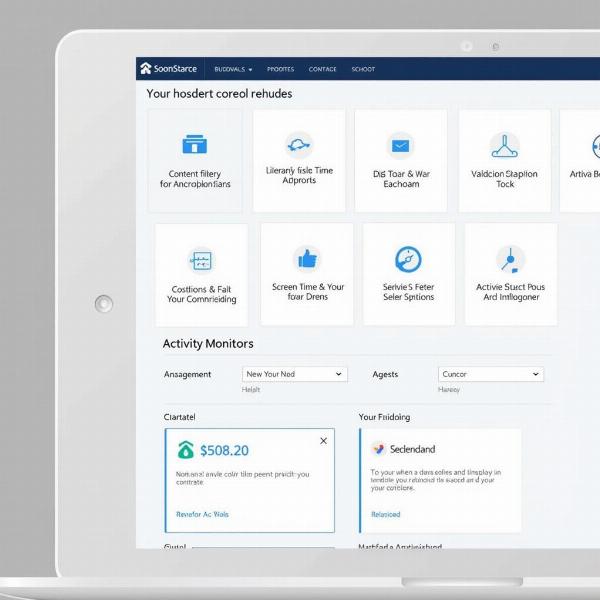Parental control, a term increasingly relevant in today’s digital age, refers to the tools and practices parents use to manage their children’s access to and interaction with online content and devices. In Hindi, parental control can be translated as “माता-पिता का नियंत्रण” (māta-pitā kā niyantran), which literally means “parents’ control.” Understanding the nuances of parental control is crucial for fostering a safe and healthy online environment for children in India.
Understanding “māta-pitā kā niyantran” (Parental Control)
Parental control encompasses a wide range of methods, from setting screen time limits and filtering inappropriate content to monitoring online activity and fostering open communication. It’s about finding a balance between allowing children to explore the digital world and protecting them from its potential harms. Why is this important? Because the internet, while a valuable resource, can also expose children to cyberbullying, inappropriate content, online predators, and other risks. Implementing “māta-pitā kā niyantran” helps mitigate these risks and promotes responsible digital citizenship.
How to Implement Parental Control Effectively
Effective parental control requires a multi-faceted approach. It’s not just about installing software; it’s about building a relationship of trust and open communication with your child. Here’s how you can implement “māta-pitā kā niyantran” effectively:
- Utilize Parental Control Software: Many software and apps are designed specifically for parental control. These tools allow you to filter content, manage screen time, monitor online activity, and even track your child’s location.
- Establish Clear Rules and Expectations: Talk to your children about online safety and set clear expectations for their online behavior. Discuss the potential dangers of the internet and the importance of responsible digital citizenship.
- Open Communication: Encourage your children to talk to you about their online experiences, both positive and negative. Create a safe space where they can share their concerns without fear of judgment.
- Educate Yourself: Stay informed about the latest online trends and potential risks. The digital landscape is constantly evolving, so it’s crucial to keep up with the changes.
Addressing Specific Online Risks with Parental Control
“māta-pitā kā niyantran” can be tailored to address specific online risks. For instance, content filtering can protect children from exposure to inappropriate websites and videos. Screen time limits can prevent excessive internet use and promote healthy habits. Monitoring social media activity can help identify instances of cyberbullying or online harassment.
Cyberbullying and Online Harassment
Cyberbullying is a serious concern, and parental control tools can help monitor online interactions and identify potential instances of harassment. Open communication is also key. Encourage your children to report any instances of cyberbullying they experience or witness.
Inappropriate Content
Protecting children from exposure to inappropriate content is paramount. Parental control software can filter websites and block access to certain types of content. However, it’s important to remember that no filter is foolproof. Ongoing communication and education are still essential.
 Parental Control Software Interface
Parental Control Software Interface
Conclusion: Embracing “māta-pitā kā niyantran” for a Safer Digital Future
In a world increasingly dominated by technology, “māta-pitā kā niyantran” (parental control) is not just a choice, but a necessity. By embracing these tools and practices, parents can empower their children to navigate the digital world safely and responsibly, fostering a healthier and more secure online experience. Remember, effective parental control is a combination of utilizing technology, establishing clear rules, fostering open communication, and staying informed about the ever-evolving digital landscape.
FAQ
- What is the best parental control software? There are many options available, and the best choice depends on your specific needs and budget. Research different software and choose one that offers the features you require.
- How do I talk to my child about online safety? Start by having open and honest conversations about the potential dangers of the internet. Encourage them to share their online experiences and ask questions.
- Is parental control an invasion of privacy? It’s important to strike a balance between protecting your child and respecting their privacy. Explain to your child why you are implementing these measures and involve them in the process.
- Can parental control software block all inappropriate content? While these tools are effective, no filter is 100% foolproof. Ongoing communication and education are still crucial.
- What should I do if my child is being cyberbullied? Encourage your child to report the incident to you and the relevant platform. Document the evidence and consider contacting the school or authorities if necessary.
- How much screen time is appropriate for my child? There are no hard and fast rules, and the appropriate amount of screen time varies depending on the child’s age and individual needs. Consult with experts and establish healthy limits.
- How can I stay updated about online trends and risks? Follow reputable online safety organizations and resources. Attend workshops or webinars on digital parenting.
Meaning-Hindi.in is your trusted partner for all your Hindi translation needs. We offer a wide range of translation services, including business and commercial document translation, certified and legal document translation, technical and user manual translation, website and localization translation, educational and academic document translation, express translation, and specialized translation. We understand the nuances of the Hindi language and culture, and we are committed to providing accurate and culturally sensitive translations. Contact us today at [email protected] or +91 11-4502-7584. Meaning-Hindi.in is your one-stop solution for bridging the language gap.